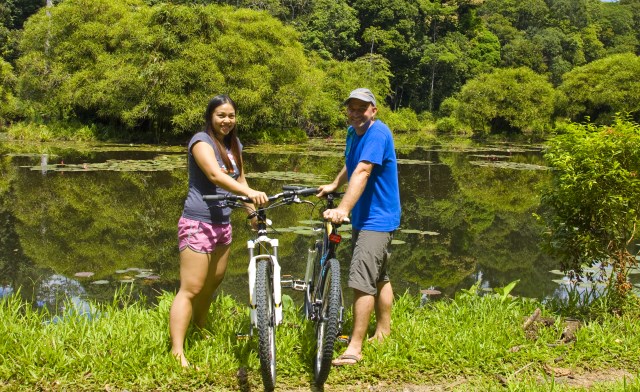Personally, I think Taliwas Forestry & Recreation Area (or Taliwas Park) in Lahad Datu is the Best Camping Site in Sabah. Whether you like rainforest, river, waterfall or lake, Taliwas Park has all these. The park is also very well-managed (by Yayasan Sabah Foundation) and camper-friendly.
Pic: beautiful Pandan Lake of Taliwas Park
However, Taliwas Park is not commercialized, so very few hear about it. Actually I learnt about Taliwas Park by accident, when I was cycling there last year.
Last year I went to Taliwas Park for a cycling trip. I did a few photo-shooting near the camping ground, because the rainforest there looked so fresh and lively under the morning rays. Taliwas Park itself is a fully-protected forest reserve.
Pic: check out the tall and dense trees above our heads!
We followed a gravel trail from the campsite of Taliwas. In about 300 Meters, we arrived an open space and Pandan Lake was just in front of us.
I was so excited about the scenery (really, because there aren’t many nature lakes in Sabah). The weather was perfect, I love the reflection of lush trees and blue sky in the lake, so I took a lot of pictures. You can click the photos to enlarge them.
Pandan Lake is a great place for picnic. Visitors also come here for bird watching, wildlife sighting and kayaking.
Pic: a huge and old strangler fig tree in the park
Below is a video of Pandan Lake:
My “discovery” of Taliwas Park was started with a cycling tour with Bike and Tours in Lahad Datu. We started at Silam junction which led to a long gravel road flanked by dense wood, oil palm plantation and village houses. For safety, a 4WD will accompany the cyclists.
Pic: cycling in the countryside of Lahad Datu
This area is very near to the forest reserves. If you are lucky, you would see herd of Bornean pygmy elephants on the road. The cycling distance was about 20 KM and we stopped at Taliwas Park for a dinner.
Pic: Tisha busy cooking food in Taliwas Park
Then you can enjoy a candle light dinner next to the river of Taliwas. There is no restaurant in the park, so Simon and Tisha (from Bike and Tours) prepared the food and setup the table for us. They made some BBQ seafood, mashed potato and chicken wings, which were really delicious. It’s a very creative way of dining for honeymooners lol.
Camping Ground & Amenities
Ok, let’s see more about Taliwas Forestry & Recreation Area (Taliwas Park), so you know why it is an excellent camping site. Taliwas Park is 39 KM away from Lahad Datu town (see Location Map). The road 20 KM before Taliwas Park is unsealed and can be muddy in wet season, so you better go there by 4-Wheel Drive (or by cycling like what I did). The park has water and electricity supply.
Pic: entrance of Taliwas Forestry & Recreation Area
Pic: the camping ground of Taliwas Forestry & Recreation Area is vast and can accommodate hundred of campers.
Pic: the river in Taliwas Park is shallow and clean, very suitable for a swim. The water is so clear that I can see many big fishes swimming. Sorry, we are not allowed to catch them.
Pic: the toilet and bathroom of Taliwas Forestry & Recreation Area
Pic: the cooking and dining area of Taliwas Forestry & Recreation Area
Pic: Barbecue grill stand and bench in the park
Pic: the activity area, where group of campers can gather here to do some activities.
Pic: they even have a small stage for function
Pic: shelter in Taliwas Forestry & Recreation Area
Pic: verandah
Pic: above is the layout map of Taliwas Park, you can click it to enlarge.
If you like waterfall, you can trek an hour in a jungle trail to reach there. Someone posted some nice photos of camping and Taliwas Waterfall, which I don’t have.
Fees & Contact
Pic: Reception and Information Building at Taliwas Park. You must check-in here before you enter the campsite. For booking and enquiry, please call them at +60 89-880825 / +60 89-823110 / +60 89-823111, or e-mail to Ms Fevayati Jimang (feva_fj@yahoo.com) / Ms Zalilah Ali (alizalilah@yahoo.com).
Pic: office of Taliwas management (named Danum Valley Field Centre)
The management of Taliwas Park also has an office opposite to Lahad Datu Airport. Below is their opening hours:
Mon-Thu: 8am-1pm, 2pm-5pm
Friday: 8am-11.30am, 2pm-5pm
Sat & Sat: closed
Taliwas Forestry & Recreation Area has a Facebook page too if you want to in touch with them online.
Please note Malaysia school holiday is the peak season for schools and nature clubs to organise holiday camp or educational tours in Taliwas Park. The park can be crowded and noisy during that period. Anyway, the park is quite empty in other times.
Above is the list of services and charges (fee in Malaysian currency (RM), RM1 ≈ USD$0.33) I copied from their Facebook page, quite exhaustive. They really know what campers need and cover everything from charter transport, renting camping tent, guide service, cooking utensils, packed meals, pillow, sleeping bag, etc. The camper almost can come here without bringing anything (except some clothing to change, cash and personal toiletries).
More Photos
Do you know any other nice camping ground in Sabah? Please share with me.
Photos taken in Lahad Datu, Sabah, Malaysia Borneo
